CSC/ECE 517 Fall 2010/ch3 S30 RJ
Decomposition, Message Forwarding, and Delegation versus Inheritance in OOP Design
Most OOP overviews explain what the concept of Inheritance is in Object Oriented Programming, and how Inheritance works, but not many OOP overviews discuss alternatives when Inheritance may not be the best design choice for an OO application. This topic briefly introduces the OOP concepts of Inheritance, Decomposition, Message Forwarding, and Delegation, and then discusses when the concepts could be considered as potential alternatives to the use of Inheritance for some OOP applications.
Beginning OOP developers often feel compelled to use Inheritance aggressively to achieve the advertised benefit of code re-use for their applications. However the full life cycle of an OO application needs to be considered. Developers usually agree more coding time will be spent maintaining and enhancing an OO application after it is developed, compared to the coding time needed to initially develop the application. In this context, it is often better to use Decomposition, Message Forwarding, and Delegation techniques instead of inheritance techniques for an application. These techniques can provide more flexibility in the maintenance and enhancement aspects of an OO application.
It needs to be noted that different OOP authors interchange and blur the meaning of what is meant by Decomposition, Message Forwarding, and Delegation in OOP. In general, discussions about Decomposition, Message Forwarding, and Delegation in the context of OOP are suggesting alternative ways to accomplish OOP designs other than utilizing a traditional OOP design that uses pure Inheritance principles.
Inheritance in OOP Design
Inheritance is one of the key concepts in Object Oriented Programming. In OOP, parent classes describe and define attributes and capabilities of objects in a parent class. Subsequently subclasses can be defined to create objects that inherit or acquire attributes and capabilities from the parent class. Parent classes are also known as the Superclass of the child, or subclass. Programming code that is created to describe the attributes and methods of objects in a parent class can easily be reused by objects that are created in subclasses of the parent class. Using inheritance in a OO application is appropriate when the relationship between the Superclass and subclass is a 'Is-A' relationship.
Inheritance Example
Consider the concept of single inheritance through class extension [1]
class Fruit {
//...
}
class Apple extends Fruit {
//...
}
In the code above, class Apple is related to class Fruit by inheritance, because Apple extends Fruit. In this example, Fruit is the superclass and Apple is the subclass.
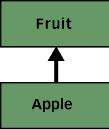
Decomposition in OOP Design
A useful starting definition for Decomposition in OOP is "In OO decomp, we think in terms of identifying active, autonomous agents which are responsible for doing the work, and which communicate with each other to get the overall problem solved." [2]
The 'autonomous agents' mentioned above would correspond to designing several different objects that each have suitable functionality that together allow a task or process to be performed, rather than taking the time to design a grand Superclass and subclass inheritance hierarchy which contains one or a few overly complex objects that are required to address a given task or process. Mixins in Ruby on Rails would be an example of decomposition in OOP, since Mixins allow useful methods from classes to be easily mixed-in, or used as utility methods by classes that may not be suitably related in a traditional inheritance hierarchy.
Composition in OOP Design
In OOP literature, discussions that mention object oriented decomposition often also discuss the topic of object oriented composition. An alternative to an inheritance relationship is a composition relationship[3], whereby instance variables of one object refer to other objects.
Composition Example
class Fruit {
//...
}
class Apple {
private Fruit fruit = new Fruit();
//...
}
In the example above, class Apple is related to class Fruit by composition, because Apple has an instance variable that holds a reference to a Fruit object. The UML diagram for this composition relationship is shown below in Figure 2.
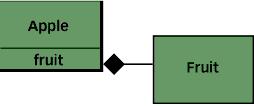
In this example, Apple can be called the front-end class, and Fruit is called the back-end class. In a composition relationship, the front-end class holds a reference in one of its instance variables to a back-end class. With inheritance relationships, it is usually easy to add new subclasses, however changes made to the interface of the Superclass in an inheritance relationship are often said to be 'fragile', because such changes may cause problems for subclasses in the relationship, and at times cause 'rippled' problems for all subclasses of the superclass.
How do composition and inheritance compare with each other?
- It is easier to change the interface of a back-end class (composition) than a superclass (inheritance). As the previous example illustrated, a change to the interface of a back-end class necessitates a change to the front-end class implementation, but not necessarily the front-end interface. Code that depends only on the front-end interface still works, so long as the front-end interface remains the same. By contrast, a change to a superclass's interface can not only ripple down the inheritance hierarchy to subclasses, but can also ripple out to code that uses just the subclass's interface.
- It is easier to change the interface of a front-end class (composition) than a subclass (inheritance). Just as superclasses can be fragile, subclasses can be rigid. You can't just change a subclass's interface without making sure the subclass's new interface is compatible with that of its supertypes. For example, you can't add to a subclass a method with the same signature but a different return type as a method inherited from a superclass. Composition, on the other hand, allows you to change the interface of a front-end class without affecting backend classes.
- Composition allows you to delay the creation of back-end objects until (and unless) they are needed, as well as changing the back-end objects dynamically throughout the lifetime of the front-end object. With inheritance, you get the image of the superclass in your subclass object image as soon as the subclass is created, and it remains part of the subclass object throughout the lifetime of the subclass.
Message Forwarding in OOP Design
Message forwarding between objects, as implemented in dynamic typing OO languages such as Objective-C, provides an alternative to inheritance relationships between objects that are statically determined at compile time. Using message sending, an object can always forward a message to another object in case it does not know how to handle the message. Alternately, an object can forward a message to another object intentionally, based on some criteria within the message. In OOP message forwarding incorporates concepts that are used to describe delegation (see next section) and composition.
Message Forwarding Example
Figure 3 below is a depiction of message forwarding, as implemented by the language Objective-C.
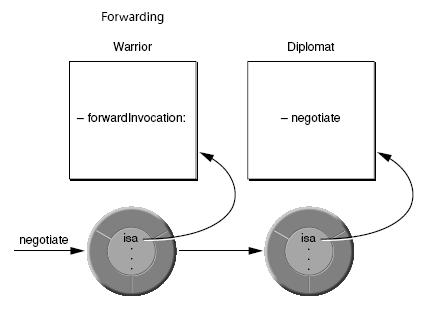
In this illustration, an object sends a negotiate type of message to the Warrior object, expecting the Warrior object to fully handle and manage this negotiate message request. However, unknown to the original object sender, when the Warrior object receives this message, the Warrior object chooses to forward the negotiate message on to an object from the Diplomat class. The Diplomat object processes the negotiate message, and sends it's response back to the Warrior object, which in turn returns the message response back to the original sender. In this illustration the Warrior object explicitly recognized the negotiate message should be sent to the Diplomat object to be processed. Other OOP message forwarding techniques, such as implemented in Objective-C, allow objects to forward any 'unrecognized' messages they have received to objects that specifically exist to process unexpected messages. [4]
Message forwarding in a dynamic language like Objective-C can provide better design time flexibility and run time flexibility to applications versus a traditional inheritance design and implementation. During the development of an OO application, many design issues are not yet fully determined. It's a lot easier to work out how your framework is supposed to behave without having to start out in a most-factored state, with plenty of empty interface fluff. A dynamic language like Objective-C lets you use static typing as well, so once you settle on a design, you can declare your types with no penalty. Best of both worlds. "Objective-C Dynamite!" [5]
Delegation in OOP Design
Delegation is defined as: The notion that an object can issue a message to another object in response to a message. The first object therefore delegates the responsibility to the second object [6]. The Gang of Four discuss delegation in their introduction to the Design Patterns book [7]. Delegation is a way of making composition as powerful for reuse as inheritance.
Basics of delegation
Two objects are involved in delegation. There is the object that receives a message, and the object that it delegates the responsibility to. It can be shown in a UML class diagram as the following:
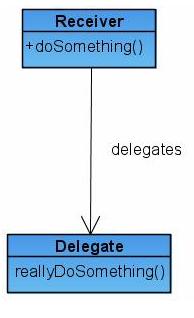
Relation to inheritance
Delegation is often used instead of inheritance to produce robust designs. With inheritance, a subclass will often "delegate" the response to a specific message to the parent class as shown in the following diagram:

In this case, when the doSomething() method is invoked upon the Child object, it delegates the handling of the message to its parent.
Static vs. Dynamic delegation
Inheritance represents a static relationship between classes. If you have child Class S that is a subclass of a parent Class P, you cannot change that relationship. Any instance of S will inherit the behaviors and members of P. Once the relationship is defined, you cannot change it. Clearly, the subclass can override the behavior, but again, this is static. The actual method that will handle the message is known at compile time.
Delegation, on the other hand, is a dynamic relationship. You can change the object that is the target of the delegation. That is, the receiver of the message can decide who should handle the message. Delegation in OOP strives to allow one object to reuse functionality that another object can readily provide. Delegation in OOP can therefore be said to realize the benefits of code reuse, but not in an official OOP code reuse manner that is usually implied as a reason for implementing traditional OOP inheritance. Instead of creating new code in a parent or Superclass that can then be reused by a child or subclass object, delegation invokes services from other objects, thereby taking advantage of code that already exists to support the other existing object.
Delegation Example
A classic example of Delegation would be a university setting that involves people who can be students at the university as well as employees of the university. The diagram below illustrates an inheritance view of these relationships:
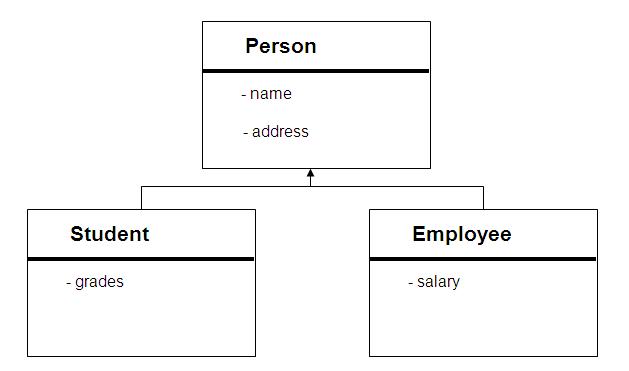
In the above diagram, if a person was both a student and also an employee of the university, there would be three objects representing the person: a person Superclass object, and then student and employee subclass objects. If the person's relationship status would change over time due to graduation or quitting their job, the task of keeping all three objects for the person updated could become difficult.
However using delegation, a person object could be created for each real person associated with the university, and then different objects representing the 'role' the person currently assumes could also be created. A delegation diagram is shown below:
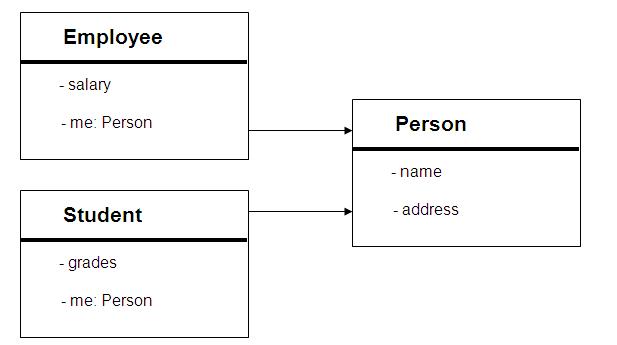
In the above diagram, any time the student or employee object needed address information for a person, the student or employee object would would send a message to the person object to obtain this information. The address information would not be duplicated in each of the three person, student, and employee objects associated with the real person. As a person's roles change within the university, such as the person becoming an instructor, creating a new object to handle the role of instructor would be easier using delegation than it would be using inheritance.
Conclusions
This topic briefly described several alternate OOP design techniques that can be considered versus the traditional Inheritance OOP design technique. Programmers should explore the options of Decomposition, Message Forwarding, and Delegation when designing OOP applications. Initial temptations to aggressively use Inheritance techniques for an application may backfire if the application survives for a long time after initial development.
References:
[1] http://www.javaworld.com:80/javaworld/jw-11-1998/jw-11-techniques.html
[2] http://www.atomicobject.com/pages/Motivation+for+OO
[3] http://www.javaworld.com:80/javaworld/jw-11-1998/jw-11-techniques.html
[5] "Objective-C Dynamite!" http://macdevcenter.com/lpt/a/3642 "Objective-C Dynamite!"
[6] Larman, Craig. Applying Uml and Patterns. Upper Saddle River: Prentice Hall PTR, 2005.
[7] Gamma, Erich. Design Patterns. Boston: Addison-Wesley, 1995.